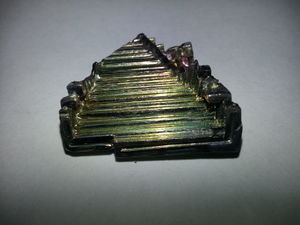Bismuth
 | |||||
| General properties | |||||
|---|---|---|---|---|---|
| Name, symbol | bismuth, Bi | ||||
| Alternative name | wismuth | ||||
| Appearance | silvery solid, often with rainbow layer of bismuth oxide. | ||||
| Bismuth in the periodic table | |||||
| |||||
| Atomic number | 83 | ||||
| Standard atomic weight (Ar) | 208.98040 | ||||
| Group, block | , p-block | ||||
| Period | period 6 | ||||
| Electron configuration | |||||
| Physical properties | |||||
| Silvery,rainbow when oxidized. | |||||
| Phase | solid | ||||
| Melting point | 544.7 K (271.5 °C, 520.7 °F) | ||||
| Boiling point | 1837 K (1564 °C, 2847 °F) | ||||
| Density at (0 °C and 101.325 kPa) | 9.78 g/cm3 g/L | ||||
| Atomic properties | |||||
| Crystal structure | | ||||
| Mohs hardness | 2.25 | ||||
Bismuth is a chemical element with symbol Bi and atomic number 83. It is a post-transition metal, grey and dense. This metal is known to be among the least toxic heavy metals.Bismuth-209 is currently known as isotope with longest decay half-time of all radioactive elements calculated to be (1.9 +/- 0.2 ) x 1019years, which is in good agreement with the theoretical prediction of 4.6 x 1019years.[1]
Contents
Properties
Chemical
Bismuth is stable to both dry and moist air at ordinary temperatures. When red-hot, it reacts with water to make bismuth trioxide[2].
- 2 Bi + 3 H2O → Bi2O3 + 3 H2
Bismuth dissolves in concentrated sulfuric acid to make bismuth(III) sulfate and sulfur dioxide.
- 2 Bi + 6 H2SO4 → 6 H2O + Bi2(SO4)3 + 3 SO2
Bismuth reacts with halogens to produce bismuth halides. Unlike bismuth trifluoride and bismuth triiodide, bismuth trichloride and bismuth pentafluoride rapidly hydrolyse in moist air and water. Bismuth will react with most acids, but oxygen or hydrogen peroxide has to be present to oxidize the metal.
Physical
Bismuth is a brittle white-silver metal in its pure form. It will oxidize in air to form an iridescent hue, under certain circumstances, showing many colors from yellow to blue. It has the lowest thermal conductivity of all known metals and it is the most diamagnetic pure element. Small samples of bismuth metal can levitate in the presence of strong magnetic fields. Similar to antimony, gallium, germanium and silicon, bismuth is denser in the liquid phase than the solid (like ice), expanding 3.32% on solidification.
Availability
Bismuth is present as bismuth subsalicylate in Pepto-Bismol. It can be extracted from the compound, as shown here.
Large chunks of metal can be bought as Hopper crystals, that display beautiful iridescence.
Bismuth is found in certain electronics, mostly as lead-free solder. The solder that binds the ceramic lid to the CPU appears to be mostly of bismuth, as after melting it and letting it cool in open air it displays the typical iridescence.
Some gun stores advertise shotgun pellets made of bismuth or alloys thereof as "green", or non-toxic ammo, as opposed to lead pellets.
Preparation
Bismuth can be extracted from Pepto-Bismol, by adding acid and then reducing the metal with either aluminium or other reducing metal.
Projects
- Making bismuth crystals
- Levitation with magnets
Handling
Safety
Unlike it's surrounding metals (lead, antimony, polonium), bismuth and bismuth compounds have low toxicity. Overexposure to bismuth, however, can result in the formation of a black deposit on the gums, known as a "bismuth line".
Some of its compounds, such as bismuth chloride will hydrolyze in moist air and is corrosive to skin, so protection is required when handling the compound.
Bismuth is technically radioactive; its naturally occurring isotope bismuth-209 is not fully stable. But its half-life is so high and radioactivity so low that it can be considered stable for all intents and purposes. It does not pose a radioactive hazard.
Storage
Bismuth does not require special storage. Hopper crystals can be displayed on any shelf or table.
Disposal
It's best to try to recycle the bismuth and avoid dumping it in the environment.
References
- ↑ http://physicsworld.com/cws/article/news/2003/apr/23/bismuth-breaks-half-life-record-for-alpha-decay
- ↑ http://en.wikipedia.org/wiki/Bismuth